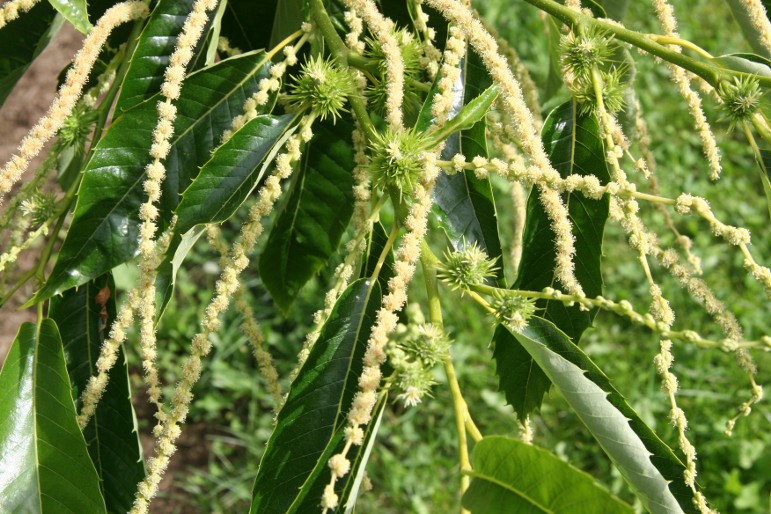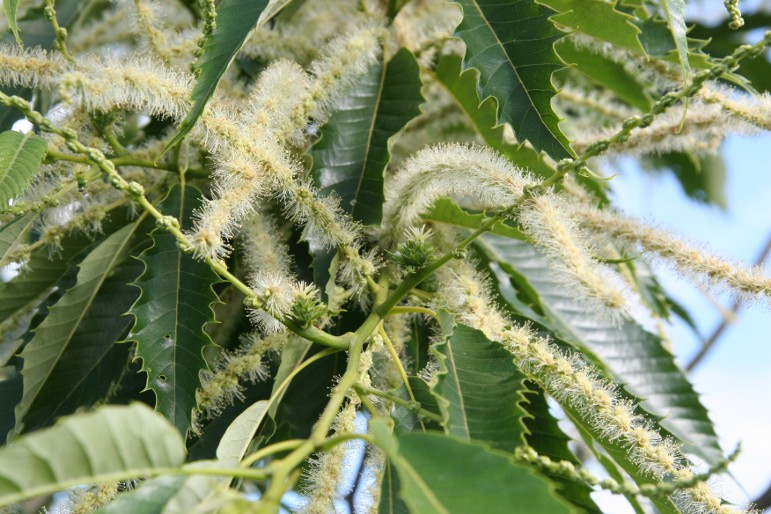| |
When chestnut growers talk about pollen production in their orchards some
persistent problems are often discussed. Here is a list of some of the topics:
Are some chestnut cultivars pollen sterile?
Are some chestnut cultivars excellent pollen producers?
How important is bloom timing?
Is there a timing difference between the male and female blooms?
How is the pollen transported between the male flowers(catkins) and the female
flowers?

Belle Epine chestnut tree in bloom
Pollen production, timing and transport are what are really being addressed.
Like in a manufacturing plant, resources need to be transported into and out
of the facility in a timely way to keep production going. Let.s get down to a
few basic rules about chestnut production as it is related to pollen production.
Rule #1 - The more energy a chestnut tree puts into pollen production, the
less energy is available for nut production. Trees that produce lots of pollen
usually produce fewer pounds of chestnuts.
Rule #2 - Just because there is lots of pollen in the orchard does not equate
to higher nut set. Environmental factors such as weather, soil nutrients, and
soil moisture can cause chestnuts not to set nuts.
Rule #3 - There is no such thing as a pollen sterile chestnut tree. There are
chestnut cultivars referred to as sterile such as Bouche de Betizac, Colossal,
and Marrisard. These cultivars do produce small amounts of pollen but not
enough to be considered a pollen producer.
Rule #4 - Clonally propagated chestnut cultivars will not set fruit with their
own pollen. In the fruit production industry this is referred to as self
sterile. A Maraval will not set fruit from its own pollen or from another
Maraval tree. This is true for all chestnut cultivars. It is not true for
seedlings of pollen producing chestnut trees since seedlings are not clonally
propagated.
Pollen transport is an important matter in getting the pollen from the male
catkins to the female flowers. There are two transport mechanisms for
transporting the pollen, insects and wind. The experts will not agree on which
of these two mechanisms is most important to chestnut production. Casual
observations in orchards demonstrates wind is the primary transport mechanism.
We also observe lots of insects on the blooms. Chestnut blooms do not appear
to produce nectar so the insect activity is in the collection of the protein
rich pollen from the male catkins.

Maraval chestnut tree in bloom
So if wind is the primary mechanism of pollen transport, how far is the pollen
transported by the wind? We have to go back into the orchards for find
evidence of the transport of the pollen to the female flowers. Casual
observations in chestnut orchards have shown a good pollen producing tree such
as Prococe Migoule, can have nearly 100 percent effective pollen transport
over 60 feet from the tree. As the distance from the tree becomes more the
effective pollen transport diminishes until about 120 feet. At 120 feet or
more away from a good pollen producing tree, very few nuts are set.
Just transporting the pollen from the male flower to the female flowers is not
good enough. Both have to be in bloom at the same time. Overall, if you have
all European hybrid chestnut cultivars, or have all Chinese cultivars, timing
is less of an issue as compared to if you have a mixed orchard of both European
and Chinese trees. Normally, the Chinese chestnut trees bloom earlier than
the European trees. If your orchard uses Colossal as your primary producer,
then you would not want to use Chinese chestnut cultivars or Chinese seedlings
for pollen production because of the difference in bloom times.
Traditionally, commercial chestnut orchards have used 2 -3 cultivars. An
example is using the Colossal as the primary nut producer and Prococe Migoule
for the pollen production. Some orchards will add a third pollen producing
tree like Marsol, Marigoule, or Maraval. Adding a second pollen producing
cultivar helps with risk management if one of the pollen producing cultivars
is unable to produce pollen in a particular year. In orchards where the
primary nut producer is a Bouche de Betizac or a Colossal, cultivars labeled
as sterile, and there is only one other pollen producing cultivar present, the
pollen producing cultivar also sets nuts. This is because the primary nut
producing cultivar does produce some pollen, but not enough if there were only
two standalone trees, one sterile tree and one pollen producing tree.
There are several designs for distributing pollen producing cultivars in
orchards using pollen sterile cultivars for nut production. When selecting a
design, wind direction during the bloom is the primary factor in the selection
process. Let.s assume a chestnut orchard is located where the wind changes
direction during the day, coming from the east in the morning and then from
the west in the afternoon. In a simple block layout of 9 trees, blocks can be
assembled next to each other for the entire extent of the orchard. Here is a
simple 9 tree block design where N = primary nut producer and P = pollen
producer:
Here is example using two different pollen producers, P1 and P2:
| Block #1 | Block #2 | Block #3 | Block #4 |
| N | N | N | | N | N | N |
N | N | N | | N | N | N |
| N | P1 | N | | N | P2 | N |
N | P1 | N | | N | P2 | N |
| N | N | N | | N | N | N |
N | N | N | | N | N | N |
In locations where the wind always comes for the same direction, say right to
left then the block layout would look something like this:
<<<< wind direction
Here is another example using, two different pollen producers, P1 and P2:
| Block #1 | Block #2 | Block #3 | Block #4 |
<<<< wind direction
| N | P1 | N | | N | N | P2 |
N | N | N | | N | N | P1 |
| N | N | N | | P2 | N | N |
N | N | P1 | | N | N | N |
| N | P2 | N | | N | N | P1 |
N | N | N | | N | N | P2 |
Whatever the layout design of the orchard, there should be at least 11 percent
pollen producing trees. Many orchards are designed with about 15 percent
pollen producing trees.
The soil nutrient and moisture components of the orchard are very important.
Deficiencies in soil nutrients can and will result in lower than expected
production in nut quantity, nut size, and nut quality. Consider performing
soil and leaf sampling every year and sending the samples to a reliable lab.
Keep records of the lab results so you can adjust your orchard practices to
achieve the highest production possible.
In the game of chestnut production, you will need to play by the rules and put
a game plan together to deliver a highly productive orchard. Customers expect
the chestnuts to be available year after year without interruption, in high
quality, easy to peal, and good tasting. Most success stories have hard work,
a great plan, and excellent execution in them. Hopefully, your orchard will
someday exceed your expectations.
|
|
|
|
Contact Information:
Farm Location:
6160 Everson Goshen Rd
Everson, WA 98247
Ph: (360) 592-3397
Email: chestnuts.wa@gmail.com
Business Offices:
Washington Chestnut Company
6160 Everson Goshen Rd.
Everson, WA 98247
Ph: (360) 592-3397
|
|


